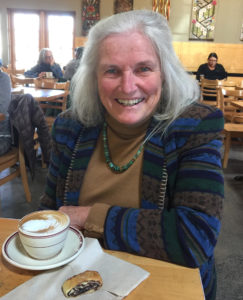
Posted by: The Sumaira Foundation in NMO, ON, Patient.e, Voices of NMO
 Ann and her husband were at the seaside, collecting seaweed to use in a kitchen garden they were digging. Ann noticed a tightness in and around her chest, but assumed the hard work was causing the strange sensation. The tightness, like a band around her body, lasted for a few days. Ann went to the doctor, who thought she had an inflammation, and he gave her a seven-day course of steroids. The symptoms improved a bit, but a few weeks later, on the Friday before Memorial Day, while Ann was playing tennis, the tightness in the band returned, along with a sense of a distended stomach and a slight numbness in her right foot.
Ann and her husband were at the seaside, collecting seaweed to use in a kitchen garden they were digging. Ann noticed a tightness in and around her chest, but assumed the hard work was causing the strange sensation. The tightness, like a band around her body, lasted for a few days. Ann went to the doctor, who thought she had an inflammation, and he gave her a seven-day course of steroids. The symptoms improved a bit, but a few weeks later, on the Friday before Memorial Day, while Ann was playing tennis, the tightness in the band returned, along with a sense of a distended stomach and a slight numbness in her right foot.
Over the long weekend, the numbness climbed Ann’s right leg, and spread to her left. First thing Tuesday morning, she called her doctor again. He thought she might be suffering from transverse myelitis, and sent her for an MRI and then to a neurosurgeon.
Ann was devastated when the neurosurgeon showed her the images, which he interpreted as showing a tumor on her spinal cord. A second surgeon told her they would have to remove a vertebra in order to get to the tumor, and then replace that vertebra. This surgeon ordered a lumbar puncture for further confirmation, and scheduled her for immediate surgery. The operation was to take place in the suburban hospital near her home.
Luckily for Ann, her brother intervened, and insisted she get another opinion from a major Boston hospital. She went to the emergency room at Massachusetts General Hospital, where a neurologist said they should “take a step back from the word tumor.” Instead, he saw a lesion, and wanted to investigate further to determine the cause of her leg’s tingling and numbness. After additional tests including a lumbar puncture, the neurologist confirmed the diagnosis of transverse myelitis.
Ann checked into the hospital, and was pummeled with steroids and poked and prodded for five or six days. Though neither the strange numbness in her legs nor the tight band around her chest improved, she was sent home. She was frustrated that, despite a diagnosis and invasive treatment, her symptoms were the same as when she went into the hospital. She feared her legs could get worse. At this point, she could walk, albeit slowly.
Five years later, Ann has not experienced a relapse. But neither have her symptoms disappeared. She has learned to live with heaviness in her legs and a tight chest. She walks, still slowly, and has to remind herself to look up, rather than at the ground beneath her feet.
Ann feels lucky. Lucky that she has had only a single attack in five years. Lucky that she was already retired from teaching health and physical education, as well as coaching, when it happened. Lucky to have gone to Boston for a second opinion. Lucky to still be walking, swimming and playing tennis, and living a full life. Still, she lives with constant discomfort, and she moves carefully. At least, until she gets to the tennis court. Though her partners are older and less competitive than the people she used to play with, Ann still makes her way to the tennis court for joyful games of doubles.
As told to Gabriela Romanow on 12/5/17